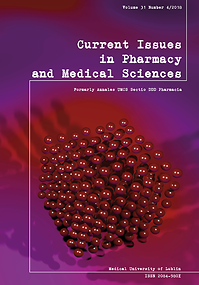BK Virus in Cancer Development
DOI:
https://doi.org/10.1515/cipms-2018-0014Keywords:
BK virus, cancer, cell transformationAbstract
Polyomavirus (PyV) was discovered by accident in 1950 in the course of describing an infectious factor causing multiple tumours in rodents. The term is derived from two Greek words: poly (many) and oma (tumour). At present the family of human polyomaviruses (HPyV) consists of 10 members. One of the first members was BK virus, isolated in 1971 from the urine of a renal transplant patient. Serological examinations have shown that due to its ability to cause latent infection, about 90% of the general population can have specific antibodies attesting infection. In the case of infected persons with normal immunity, this virus is not dangerous. In the impaired immunity, however, loss of immunity results in virus reactivation and development of many life-threatening illnesses. Serological examinations have also reveal that BK polyomavirus considerably affects the development of cancers in humans. Hence, in 2012 a group of 26 researchers from 11 countries associated with the International Agency for Research on Cancer (a part of the World Health Organisation) classified BK polyomavirus within group 2B - “potentially carcinogenic to humans”.
References
1. Dalianis T, Hirsch HH. Human polyomaviruses in disease and cancer. Virology. 2013:437(2):63-72.
2. Neu U, Stehle T, Atwood W.J. The Polyomaviridae: Contributions of virus structure to our understanding of virus receptors and infectious entry. Virology. 2009;384:389-399.
3. Rynans S, Dzieciątkowski T, Młynarczyk G. Zakażenia ludzkimi poliomawirusami osób poddanych immunosupresji. Post Microbiol. 2011;50(3):191-199.
4. Johne R, Buck CB, Allander T, Atwood WJ, Garcea RL, Imperiale MJ, et al. Taxonomical developments in the family Polyomaviridae. Arch Virol. 2011;156:1627-34.
5. Knowles WA. Discovery and Epidemiology of the Human Polyomaviruses BK Virus (BKV) and JC Virus (JCV). Adv Exp Med Biol. 2006;577:19-45.
6. Hirsch HH, Randhawa P. BK Polyomavirus in Solid Organ Transplantation. Am J Transplant. 2013:13:79-188.
7. Matłosz B, Durlik M. Śródmiąższowe zapalenie nerki przeszczepionej wywołane wirusem Polyoma BK. Przegl Epidemiol. 2006:60;133-140.
8. International Agency for Research on Cancer IARC monographs on the evaluation of carcinogenic risks to humans. Volume 104: Malaria and some polyomaviruses (SV40, BK, JC, and Merkel cell viruses). Lyon, France: IARC; 2012.
9. White MK, Khalili K. Polyomaviruses and human cancer: molecular mechanisms underlying patterns of tumorigenesis. Virology. 2004:324:1-16.
10. McCabe MT, Low JA, Imperiale MJ, Day ML. Human polyomaviruses BKV transcriptionally activates DNA methyltransferase 1 though the pRB/E2F pathwey. Oncogene. 2006;25:2727-2735.
11. Dalianis T, Hirsch HH. Chapter 16: BK polyomavirus and transformation. In: Robertson ES (ed): Cancer Associated Viruses. New York: Springer Science and Business Media, LLC. 2012;419-432.
12. Narayanan M, Szymanski J, Slavcheva E, Rao A, Kelly A, Jones K, et al. BK Virus Associated Renal Cell Carcinoma: Case Presentation with Optimizes PCR and Other Diagnostic tests. Am J Transplant. 2007;7:1666-1671.
13. Geetha D, Tong BC, Racusen L, Markowitz JS, Westra WH. Bladder carcinoma in a transplant recipient: Evidence to implicate the BK human polyomavirus as a causal transforming agent. Transplantation. 2002;73:1933-1936.
14. Emerson LL, Carney HM, Layfield LJ, Sherbotie JR. Collecting duct carcinoma arising in association with BK nephropathy post-transplantation in a pediatric patient. A case report with immunohistochemical and in situ hybridization study. Pediatr Transplant. 2008;12:600-605.
15. Kausman JY, Somers GR, Francis DM, Jones CL. Association of renal adenocarcinoma and BK virus nephropathy post transplantation. Pediat Nephrol. 2004;19:459-462.
16. Knoll A, Stoehr R, Jilg W, Hartmann A. Low frequency of human polyomavirus BKV and JCV DNA in urothelial carcinomas of the renal pelvis and renal cell carcinomas. Oncol Rep. 2003;10:487-491.
17. Rogers R, Gohh R, Noska A. Urothelial cell carcinoma after BK polyomavirus infection in kidney transplant recipients: A cohort study of veterans. Transpl Infect Dis. 2017 e12752
18. Imperiale MJ. The human polyomaviruses, BKV and JCV: Molecular pathogenesis of acute disease and potential role In cancer. Virology. 2000;267:1-7.
19. Taghavi A, Mohammadi-Torbati P, Kashi AH, Rezaee H, Vaezjalali M. Polyomavirus Hominis 1(BK virus) Infection in Prostatic Tissues: Cancer versus Hyperplasia. Urol J. 2015;12(4):2240-4.
20. Burger-Calderon R, Webster-Cyriaque J. Human BK Polyomavirus – the potential for head and neck malignancy and disease Cancers. 2015:7:1244-1270.
21. Corallini A, Pagnani M, Viadana P, Silini E, Barbanti-Brodano G, Mottes M, et al. Association of BK virus with human brain tumors and tumors of pancreatic islets. Int. J. Cancer. 1987;39:60-67.
22. Flægstad T, Andresen PA, Johnsen JI, Asomani SK, Jørgensen G, Vignarajan S, et al. A possible contributory role of BK virus infection in neuroblastoma development. Cancer Res. 1999;59:1160-1163.
23. Arthur RR, Grossman SA, Ronnett BM, Bigner SH., Vogelstein B, Shah KV. Lack of association of human polyomaviruses with human brain tumors. J. Neuro-Oncol. 1994;20:55-58.
24. Khabaz MN, Nedjadi T, Gari MA, Al-Maghrabi JA, Atta HM, Basuni AA, et al. BK polyomavirus association with colorectal cancer development. Genet Mol Res. 2016;15(2).
Downloads
Published
Issue
Section
License
Copyright (c) 2018 Authors

This work is licensed under a Creative Commons Attribution-NonCommercial-NoDerivatives 3.0 Unported License.


